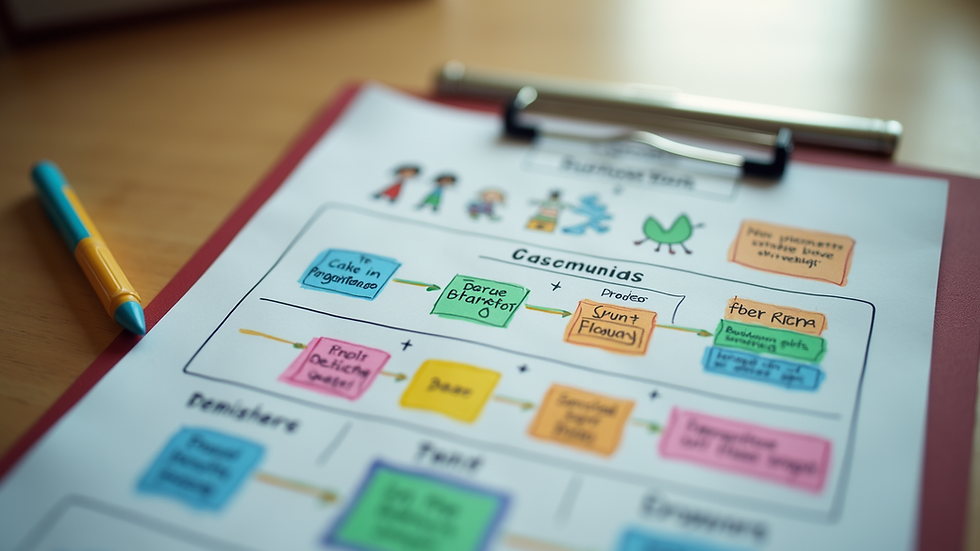Exploring the Benefits of Pediatric Occupational Therapy
- Sarah Eis
- Oct 27
- 4 min read
When we watch our children grow, every step they take is a new adventure. Sometimes, those steps come with challenges that require a little extra help. That’s where kids therapy benefits come into play, offering a warm, supportive hand to guide children through their unique developmental journeys. Today, I want to share with you the many ways therapy can nurture your child’s growth, build confidence, and open doors to new possibilities.
Understanding Kids Therapy Benefits: What It Means for Your Child
Kids therapy is a broad term that covers various approaches designed to support children’s development, behavior, and learning. Whether your child is facing sensory challenges, motor skill delays, or difficulties with social interaction, therapy can provide tailored strategies to help them thrive.
One of the most valuable aspects of therapy is its focus on the whole child. It’s not just about fixing a problem but about empowering your child to engage fully with their world. For example, therapy might include activities that improve fine motor skills, like buttoning a shirt or holding a pencil, or exercises that enhance sensory processing, helping your child feel more comfortable in noisy or crowded environments.
By working closely with therapists, families can learn practical techniques to use at home, creating a consistent and nurturing environment. This partnership is essential because it ensures that progress continues beyond the therapy sessions.

How Kids Therapy Benefits Daily Life and Development
The benefits of therapy extend far beyond the therapy room. When children receive the right support, they often experience improvements in many areas of their lives. Here are some key ways therapy can make a difference:
Improved Independence: Therapy helps children develop skills that allow them to do everyday tasks on their own, such as dressing, eating, and grooming. This independence boosts their confidence and self-esteem.
Enhanced Social Skills: Many therapies focus on communication and interaction, helping children build friendships and navigate social situations more comfortably.
Better Emotional Regulation: Therapy can teach children how to recognize and manage their emotions, reducing frustration and anxiety.
Increased Focus and Attention: For children with attention difficulties, therapy offers strategies to improve concentration and task completion.
Physical Coordination and Strength: Through targeted exercises, children can develop better balance, coordination, and muscle strength.
These benefits combine to create a foundation for success in school, at home, and in the community. When children feel supported and capable, they are more likely to take on new challenges with enthusiasm.
Is ABA or OT Better for Autism?
When it comes to supporting children with autism, many parents wonder whether Applied Behavior Analysis (ABA) or occupational therapy (OT) is the better choice. Both approaches offer valuable benefits, but they serve different purposes and can often complement each other.
ABA focuses on behavior modification through structured techniques. It helps children learn specific skills and reduce behaviors that may interfere with learning or social interaction. ABA is highly data-driven and often involves repetitive practice to reinforce positive behaviors.
On the other hand, occupational therapy takes a more holistic approach. It addresses sensory processing, motor skills, and daily living activities. OT helps children develop the skills they need to participate fully in everyday life, from playing with peers to managing self-care tasks.
Rather than choosing one over the other, many families find that combining ABA and OT provides a well-rounded support system. This integrated approach allows children to benefit from the strengths of both therapies, tailored to their unique needs.

How to Recognize When Your Child Might Benefit from Therapy
Sometimes, it’s clear when a child needs extra support. Other times, the signs are more subtle. Here are some indicators that therapy might be helpful:
Difficulty with coordination or motor skills, such as trouble holding a crayon or climbing stairs
Challenges with sensory processing, like being overly sensitive to sounds, textures, or lights
Struggles with social interaction, including difficulty making friends or understanding social cues
Delays in speech or language development
Behavioral challenges that interfere with learning or daily routines
Trouble with attention, focus, or following instructions
If you notice any of these signs, it’s a good idea to consult with a pediatrician or a specialist who can guide you toward the right resources. Early intervention is key, and the sooner your child receives support, the more positive the outcomes tend to be.
Taking the First Step: How to Begin Therapy for Your Child
Starting therapy can feel overwhelming, but it’s a journey worth taking. Here are some gentle steps to help you get started:
Gather Information: Learn about the different types of therapy available and what might suit your child’s needs.
Seek Professional Advice: Talk to your child’s doctor, teachers, or specialists for recommendations and referrals.
Find a Trusted Therapist: Look for therapists who specialize in working with children and who create a warm, welcoming environment.
Set Realistic Goals: Work with the therapist to establish clear, achievable goals that focus on your child’s strengths and challenges.
Stay Involved: Participate in sessions when possible and practice strategies at home to reinforce progress.
Be Patient and Positive: Remember that growth takes time, and every small step forward is a victory.
By approaching therapy with an open heart and a collaborative spirit, you create a foundation of trust and encouragement that supports your child’s success.
Embracing the Journey Together
Every child’s path is unique, and therapy is a powerful tool that can help unlock their potential. Through compassionate support and tailored strategies, we can help children build the skills they need to navigate their world with confidence and joy.
If you’re considering therapy for your child, I encourage you to explore options like pediatric occupational therapy. This approach offers gentle, effective support that respects your child’s individuality and promotes meaningful growth.
Together, we can create a nurturing environment where every child feels valued, understood, and empowered to shine.





Comments